Featured Articles
Impressions: Martinez, Cotto, Combat, and Sport
At 9:15 on the night of June 7, Sergio Martinez entered dressing room #5 at Madison Square Garden with trainer Pablo Sarmiento, cutman Roger Anderson, and physical therapist Raquel Bordons. Cornerman Russ Anber and Nathan Lewkowicz (the son of promoter Sampson Lewkowicz) followed. The room was small and angularly-shaped with brown industrial carpet and cream-colored cinderblock walls. Two doors down the corridor, Miguel Cotto was ensconsed in dressing room #5.
In two-and-a-half hours, Martinez and Cotto would do battle for the middleweight championship of the world. Sergio was the defending champion, but his dressing room was one-third the size of Miguel’s. Other slights had cut deeper.
The fight and all promotional material for it had been styled “Cotto-Martinez” rather than the other way around. “It bothers me,” Sergio admitted, “because it’s disrespectful to the history and traditions of boxing. But Cotto said there would be no fight if his name wasn’t first on the posters. I can imagine that, on June 7, he will ask for rose petals to be thrown at his feet or he won’t walk to the ring.”
More significantly, the finances of the fight were weighted in the challenger’s favor. Cotto and Top Rank (Miguel’s promoter) had retained Puerto Rican television rights off the top. The first $15,000,000 in net revenue after that would be split 55 percent to Cotto and Top Rank, 45 percent to Martinez and his promoters (DiBella Entertainment and Sampson Promotions). Thereafter, the split would increase to 60-40.
To Cotto, that was fair and logical. “Two times in my career – when I fought Pacquiao and when I fought Mayweather – I was the champion but I was the B-side,” Miguel noted. “I understood my position. Sergio Martinez is a great fighter, but boxing is a business. For this fight, I am the one who sells the tickets.”
A fighter’s dressing room is a sheltered world in the hours before a big fight. In Sergio’s case, the mood is constant from bout to bout; relaxed and low-key until the final minutes when smiles evaporate.
Some fighters are intimidated by the atmosphere of a big fight. Martinez thrives on it. He loves the spotlight. His 2012 bout against Julio Cesar Chavez Jr had been more personal for him than this one because of the backroom dealing that led to his championship being temporarily taken from him. But he’d reclaimed the throne in front of a raucous crowd of Chavez partisans. Now he was eager to perform on an even bigger stage.
Referee Mike Griffin came into the dressing room and gave Martinez his pre-fight instructions. Russ Anber wrapped Sergio’s hands. Martinez put on his shoes and trunks and shadow-boxed briefly. Then he pulled a protective latex sleeve up over each knee. “A precaution,” he explained. “Not a necessity.”
A precaution deemed advisable because of the surgery and rehabilitation that Martinez underwent last year.
Pablo Sarmiento gloved Sergio up. Earlier in the evening, New York State Athletic Commission inspector Ernie Morales had initialed Martinez’s handwraps. Now Sue Etkin (the other inspector assigned to Sergio) wrote “Sue” on the tape covering the lace on each glove.
Martinez hit the pads with Sarmiento.
Music played. Out of Control, sung by the group You Aren’t Going to Like This. The same song, again and again.
There was anticipation in Sergio’s eyes. Madison Square Garden . . . The middleweight championship of the world . . . A screaming bloodlust crowd of 21,090 waited. For Muhammad Ali, boxing was a sport. Joe Frazier treated it as combat. In Martinez’s mind, he was preparing for a sporting competition. Two doors down the corridor, Miguel Cotto was preparing for combat.
Like most fighters, Martinez comes from a hard world. He’s a thoughtful intelligent man, sometimes philosophical. Growing up in the slums of Buenos Aires, he didn’t know what “dinner” was. The family didn’t sit down together at an appointed hour. When food came into the home, they ate it.
“When you are very small, a child, you don’t know that you’re poor,” Sergio says, reflecting back on that time. “Even though you’re hungry and cold, if you have the love of your parents, you’re happy with what you have because you’re used to that life and it’s all you know. Then you become an adolescent. You start to realize what you don’t have and begin to think about how to get what you want. You can work hard or you can take the shorter path and turn to crime. If you have good parents, it makes a big difference in deciding which path you take. When you are an adult, you realize fully what you missed as a child. And again, you have a choice. You can feel sorry for yourself or you can feel pride at where you came from and where you’ve gotten to in life. I give thanks to the fact that I grew up poor because it helps me appreciate what I have now.”
Taken severally, Sergio’s features aren’t classically handsome. But they fit together well and his smile further binds them together. Fashion designers love to hang clothes on him. He has a strong physical presence and carries himself with grace. Every now and then, a hard look creeps into his eyes, as though he is remembering the hardships of his youth or the demands of his trade. But he’s unfailingly gracious. Women and men are drawn to him.
Boxing was Martinez’s route to a better life. “I was a good student,” he says. “But my family didn’t have the money to continue my education. Without my physical gifts, I don’t think I would have found my way out of poverty. But I believe that everyone has a path if they choose to follow it. Everyone has a talent that’s special.”
Martinez turned pro in 1997 and fought in obscurity for much of his ring career. On June 21, 2003, on what he calls “the most important day of my life,” he took a beating but won a twelve-round decision over Richard Williams in Manchester, England, to claim the unheralded IBO 154-pound title.
“It was a very hard fight for me,” Sergio recalls, “because I was not experienced at that time. But I won.”
One week later, Martinez had a tattoo of a dragon imprinted on the outside of his left arm from shoulder to elbow. In January 2013, he added the word “resistencia” (resistance) on the inside of his right forearm and “victoria” (victory) on the inside of his left forearm.
“The life I have chosen revolves around those two words,” Sergio says, explaining the latter two tattoos. “When I was preparing to fight Chavez [in September 2012], they were constantly in my head. Then I signed to fight Martin Murray. I wasn’t motivated and I thought the tattoos would help motivate me. There will be no more tattoos. I don’t like tattoos. I never wanted tattoos. I hate tattoos. It is a contradiction, I know. I cannot explain it except to say, in two brief moments in time, I thought it was important to have these tattoos on my body.”
Martinez ascended to stardom on April 17, 2010, when he decisioned Kelly Pavlik to claim the WBC and WBO middleweight crowns. Seven months later, in his first title defense, he scored a dramatic one-punch knockout of Paul Williams. Victories over Sergiy Dzinziruk, Darren Barker, Matthew Macklin, Julio Cesar Chavez, and Martin Murray followed.
“The very poor identify with boxing,” Sergio observes. “They look at boxers and relate to the economic conditions that we came from and to our struggle. They admire the courage we have to fight to get to the next level. The very wealthy look at boxers as two animals trying to kill each other for their entertainment. They don’t identify on a human level with the fighters. Many of them – I truly believe this – want to see me fail in the end, lose all my money, and go back to nothing. It’s like a game for them. And sadly, most boxers who go from very poor to very rich go back quickly to being poor again.”
Cotto-Martinez harkened back to a time when New York was the capitol of the sports world. Earlier in the day, California Chrome’s pursuit of racing’s Triple Crown had drawn a crowd of 102,000 to the Belmont Stakes. On fight night, Madison Square Garden was rocking.
Cotto was bidding to become the first Puerto Rican to win titles in four weight divisions. This would be his ninth fight in the big Garden arena and the first for Martinez. Three thousand fans had attended the Friday weigh-in. It would have been more, but the doors to The Theater at MSG were closed an hour before the fighters stepped on the scales.
Stripped of the hype, Cotto-Martinez was an entertaining match-up between two compelling personalities who have served boxing well. Each man carries himself with dignity. And while Martinez was a 2-to-1 favorite, the outcome of the fight was very much in doubt.
The case for a Martinez victory began with the belief that Cotton wasn’t “Cotto” anymore. Miguel had lost two fights in a row (to Floyd Mayweather and Austin Trout) before blowing out journeyman Delvin Rodriguez last October. Prior to those fights, he’d been brutalized by Antonio Margarito and Manny Pacquiao and looked ordinary in victories over Yuri Foreman, Ricardo Mayorga, and (in a rematch) Margarito.
Trout was thought to have given Martinez a roadmap for beating Cotto. Like Sergio, Austin is a tall southpaw. Twelve months earlier, he’d outpointed Miguel 119-109, 117-111, 117-111. Asked at a June 4 sitdown with reporters about the parallels between Trout and Martinez, Cotto responded, “I fought Trout in 2012. Now it is 2014. I never saw that fight after that night, and I have no plans to see it again.”
That seemed like a bad case of denial. Moreover, for the first time in a long time, Martinez would be entering the ring with a height (three inches) and weight (four pounds) advantage over his opponent.
“I like to watch my opponents,” Martinez says. “I like studying them a lot. More than what they do, it’s how they think. I want to know what my opponent is thinking. Once I’ve seen them, I can figure them out; the ideas they have, their plan, their strategy.”
Watching Cotto, Sergio had seen Pacquiao and Mayweather beat Miguel with speed and Margarito beat him with power.
“Cotto does not have the same power at this weight that he had at 147,” Martinez opined. “I am the power-puncher of the two of us. When I start to find my rhythm, my timing, and the right distance, the fight will be over.”
Team Cotto, of course, held to a contrary view.
Cotto would be the most intelligent and technically-skilled opponent that Martinez had faced. Freddie Roach (Miguel’s trainer) was confident that edge would enable his fighter to exploit the flaws in Sergio’s style.
“Martinez is a great athlete,” Roach said. “I wouldn’t call him a great boxer. If you keep yourself in a good position, most of the time you’ll control the fight. Sergio’s footwork is reckless. He’s all over the place. Miguel can take advantage of that. And I think Miguel can beat Martinez down the middle. Sergio’s defense is not all that good, if you exchange with him, let your hands go, he’s very hittable. Chavez didn’t do that until the last round, and you saw what happened when he did. I think Cotto’s boxing ability will be too much for Martinez to handle.”
On the issue of size and power, Cotto declared, “It’s not about gaining the weight. It’s about not having to lose the weight. For the first time in my career, I’m not concerned about making weight. I can eat to be strong.”
“We moved up the weight a little bit and put on more muscle,” Roach added. “I think Miguel will be stronger on the inside and much more physical on the inside than Martínez is. We’re going to push him around with no problem. On the inside we’re the bigger stronger fighter. Sergio is in over his head on this one.”
But the biggest issue surrounding Cotto-Martinez was Sergio’s physical condition. Some people thought that Cotto was shot. Virtually everyone believed that Martinez was fragile.
Forty-three months had passed since Sergio’s demolition of Paul Williams. Subsequent to that, he had looked vulnerable. More than most fighters, Martinez fights with his legs. But in recent fights, his legs have betrayed him.
After decisioning Martin Murray on April 27, 2013, Martinez underwent major knee surgery.
“The recuperation was very painful,” Sergio acknowledged in a May 20 teleconference call. “I was on crutches for nine months and it is very hard to come back from that. But this is the road that I chose and I enjoy the achievement of coming back from something like this. Right now, I am just the same as when there were no knee problems. I have overcome all obstacles.”
That thought was echoed by Raquel Bordons, who said in the dressing room an hour before the fight, “Sergio’s condtion is more than I could have hoped for. He is very, very good now.”
But at this stage of Martinez’s career, injuries during a fight seem as likely as not. Was he fully repaired after the surgery, or was he a 39-year-old athlete with sub-standard body parts?
Tom Gerbasi framed the issue when he wrote, “It’s almost as if Martinez making it to the ring is the equivalent of New York Knicks captain Willis Reed limping out of the tunnel for Game Seven of the NBA Finals against the LA Lakers on May 8, 1970, to inspire his team and get them off to the start they needed to win the game and the title. It’s got that feel, that buzz, that for one more night, a great champion can be great. Saturday night is Sergio Martinez’s Game Seven. But this is no basketball game. Martinez can’t hit two baskets, go back to the bench, and leave his teammates to finish the work like Reed did. This is a fight, twelve rounds with the best fighter Martinez has ever been in with. Thirty-six minutes of wear and tear, physical and mental warfare.”
“Who do you like in the fight?” boxing maven Pete Susens was asked.
“Whichever guy has one last big fight left in him,” Susens answered.
During the build-up to Cotto-Martinez, Sergio had told the media, “It has been my dream for a long time to fight in the big room at Madison Square Garden.”
On fight night, that dream turned into a nightmare.
The heavily pro-Cotto crowd was chanting “Cotto, Cotto” even before the bell to start round one rang. It didn’t have to wait long for satisfaction. One minute into the first stanza, Cotto staggered Martinez with a left hook up top. A barrage of punches put Sergio face down on the canvas. He rose on unsteady legs and, a minute later, was decked again by a right hand. Once more, he struggled to his feet. Almost immediately, a body shot put him down for the third time.
That left Martinez with quite a hole to climb out of on the judges’ scorecards. And worse, he was now a debilitated fighter.
“The first punch that hurt me, after that, I never recovered,” Sergio said in his dressing room after the fight. “I wasn’t the same after that. I couldn’t do anything. My mind was disconnected from my body. My mind told me to do something, and my body wouldn’t do it.”
A brutal beatdown followed. Cotto punished Martinez almost at will to the head and body. Everything that Miguel landed seemed to hurt. Sergio’s only hope was that Cotto would fade in the late rounds as had happened in several recent outings. But with each passing round, it became more unlikely that Martinez would have anything left if and when that eventuality occurred. As the fight wore on, the question was not who would win, but how much punishment Martinez could take. Sergio wasn’t just being outpointed. He was getting beaten up. All he had left was his heart.
After nine rounds, Pablo Sarmiento stopped the carnage. In the dressing room after the fight, the trainer recounted, “I told him, ‘Sergio, champion, you mean more to me than I mean to myself. I am stopping it now.’ Sergio pleaded with me, ‘One more round.’ I told him no, and he accepted that.”
If Cotto-Martinez was Miguel’s finest hour, it was also Sarmiento’s.
As Pablo spoke, Martinez sat on a folding cushioned chair with Raquel Bordons beside him. His face was bruised and swollen. There was a cut on his right eyelid and an ugly gash on top of his head. The right side of his body, where Cotto’s left hook had landed again and again, ached. Fortunately, a post-fight trip to Bellevue Hospital for a precautionary MRI revealed nothing more serious than a broken nose.
As for Sergio’s future, two thing that he has said in the past are instructive.
Prior to fighting Julio Cesar Chavez Jr, Martinez declared, “I always look ahead. That’s what works for me; to look toward my goals and never look away from them.” Then, in a light moment shortly before fighting Cotto, Sergio acknowledged, “I am thirty-nine, and people think that I’m an old man. For boxing, maybe I am.”
Put those thoughts together and retirement after a long and honorable career is a sound option. Meanwhile, Cotto-Martinez stands as a reminder that, for each thrilling victory in boxing, there’s a heartbreaking defeat.
Thomas Hauser can be reached by email at thauser@rcn.com. His most recent book (Reflections: Conversations, Essays, and Other Writings) was published by the University of Arkansas Press.
-
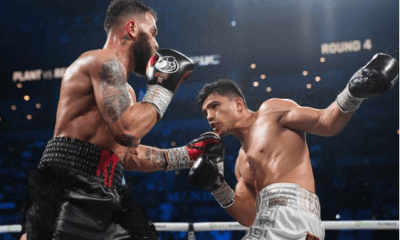
 Featured Articles4 weeks ago
Featured Articles4 weeks agoA Night of Mismatches Turns Topsy-Turvy at Mandalay Bay; Resendiz Shocks Plant
-

 Featured Articles2 weeks ago
Featured Articles2 weeks agoAvila Perspective, Chap. 330: Matchroom in New York plus the Latest on Canelo-Crawford
-
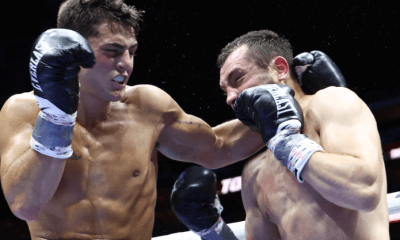
 Featured Articles1 week ago
Featured Articles1 week agoVito Mielnicki Jr Whitewashes Kamil Gardzielik Before the Home Folks in Newark
-
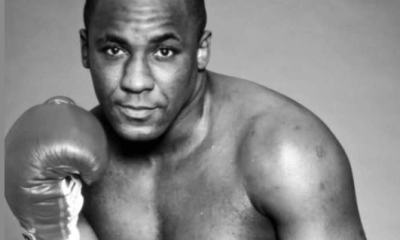
 Featured Articles4 weeks ago
Featured Articles4 weeks agoRemembering the Under-Appreciated “Body Snatcher” Mike McCallum, a Consummate Pro
-
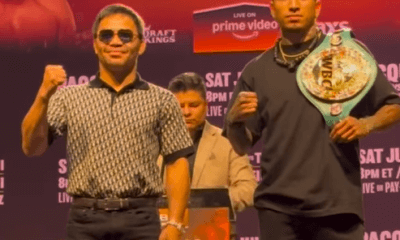
 Featured Articles4 weeks ago
Featured Articles4 weeks agoAvila Perspective, Chap 329: Pacquiao is Back, Fabio in England and More
-
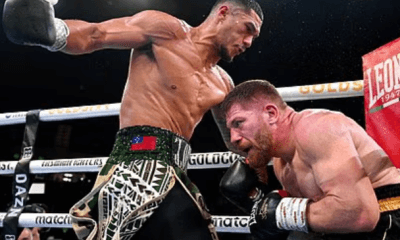
 Featured Articles3 weeks ago
Featured Articles3 weeks agoOpetaia and Nakatani Crush Overmatched Foes, Capping Off a Wild Boxing Weekend
-

 Featured Articles3 weeks ago
Featured Articles3 weeks agoFabio Wardley Comes from Behind to KO Justis Huni
-
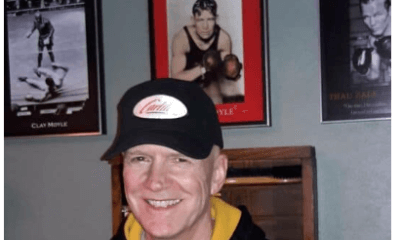
 Featured Articles2 weeks ago
Featured Articles2 weeks agoCatching Up with Clay Moyle Who Talks About His Massive Collection of Boxing Books
















